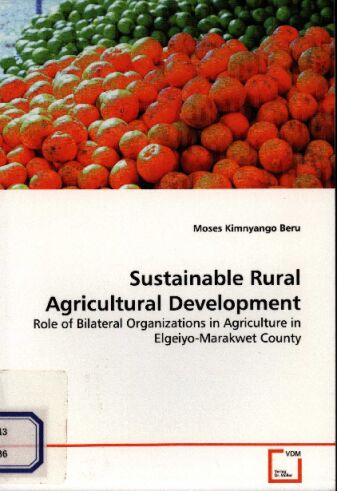书名:Sustainable rural agricultural development
责任者:Moses Kimnyango Beru.
出版时间:2011
出版社:VDM Verlag Dr. Muller,
摘要
The purpose of this study was to evaluate the role of Semi-Arid Rural Development Programme (SARDEP) in promoting sustainable agricultural development. Fifty per cent of Kenya's poor people live in the rural areas (German Embassy, 1995). Due to lack of community participation in the development process, development projects initiated by development agencies collapse after the withdrawal of these agencies. As a result, poverty has been increasing. The objectives of this study were: to identify the type of agricultural projects and services rendered by SARDEP at transect H; to establish suitability of SARDEP personnel to implement agricultural projects and disseminate agricultural services at transect H; and finally, to determine farmers' accessibility to agricultural projects and services at transect H.(A transect is one of SARDEP's areas of operations in Keiyo district. It covers an area of 15,000 hectares)
This study used the theory of community development. This theory emphasizes participatory development. A community development model adopted from Max Neef (1989) was used in this study. This theory stresses the fact that members of the community should be provided with: knowledge, be empowered to manage their own affairs, be organized into groups, priorities their needs, and work with community workers who should be professionals for development of rural areas.
The study sample included the SARDEP staff and fanners at Transect H. Ten SARDEP personnel out of twenty-five were selected to respond to questionnaire questions, five were also selected for an interview. Six farmers were selected in every group of fifteen members as respondents. There were a total of sixteen groups at transect H. Another two members per group in six groups were selected to be observed by the researcher. Data was collected using questionnaires, interview and observation schedules. In analyzing the data descriptive statistics were used.
The study established that the following farming activities, as reported by sampled farmers, were practiced: dairy (78%), horticultural and food crops (86.25%) and cash crop (70%) farming. The study also found out the services rendered by SARDEP included: extension (95%) provision of funds in form of grants (100%), organization of seminars (100%), provision of support in form of materials for construction (100%), skills on diversification of farming activities (100%), Book Keeping (100%), group management skills (100%) and project management (100%) among others. SARDEP personnel were found suitable in facilitating agricultural projects and services at transect H. Finally, it was revealed that farmers had access to the services provided by SARDEP.
The study concluded that SARDEP enhanced participatory agricultural developments at transect H. In light of this, the study recommended that SARDEP and other development agencies should venture into offering marketing, credit, research services, encourage farmers to organize tours, assist the poor and encourage poultry keeping and active women participation in agricultural sector.
查看更多
目录
DEDICATION i
ACKNOWLEDGEMENT ii
TABLE OF CONTENTS iii
LIST OF FIGURES AND TABLES v
LIST OF ACRONYMS vi
ABSTRACT viii
CHAPTER ONE 1
INTRODUCTION 1
1.0 Introduction 1
1.1 Statement of the Problem 3
1.2 Objectives 4
1.2.1 Specific objectives 4
1.3 Research Questions 4
1.4 Basic Assumptions 4
1.5 Limitations of the study 4
1.6 Justification of the Study 5
1.7 Conceptual/Theoretical framework 5
1.8 Operationalization of Key Terms 11
1.9 Organization of the study 11
CHAPTER TWO 12
LITERATURE REVIEW 12
2.0 Introduction 12
2.1 Historical Development of Bilateral Organizations 12
2.2 Semi Arid Rural Development Programme (SARDEP) 15
2.2.1 SARDEP's Objectives and Management 17
2.3 Agriculture for Sustainable Rural Development 18
2.4 Participation for Rural Development 23
2.5 Empirical Research Related to the Study 27
CHAPTER THREE 30
RESEARCH DESIGN AND METHODOLOGY 30
3.0 Introduction 30
3.1 Study Area and Population 30
3.2 Sample size and Sampling Procedures 31
3.3 Research Design 33
3.4 Development and use of the survey instruments 33
3.4.1 The Questionnaire 33
3.4.2 Interview Schedule 33
3.4.3 Observation Schedule 34
3.5 Data Collection and Administration of Instruments 34
3.6 Reliability and Validity of Research Instruments 35
3.7 Respondents Anonymity and Field Experience 36
3.7.1 Respondents Anonymity 36
3.7.2 Field Experience 36
CHAPTER FOUR 37
DATA PRESENTATION, DISCUSSIONS, ANALYSIS AND INTERPRETATION 37
4.0 Introduction 37
4.1 Background Information 37
4.2 Presentation and Analysis of Data 41
4.2.1 Farming Activities 41
4.2.2 Agricultural Services 43
4.3 Suitability of SARDEP personnel 54
4.4 Farmers'access to SARDEP's Services , 58
4.5 Summary 62
CHAPTER FIVE 64
MAIN FINDINGS, CONCLUSIONS AND RECOMMENDATIONS 64
5.0 Introduction 64
5.1 Discussion of Findings 64
5.2 Conclusions 69
5.3 Recommendations 70
5.4 Suggestions for further research 71
REFERENCES 72
APPENDICES 77
查看PDF
查看更多
馆藏单位
中国农科院农业信息研究所



